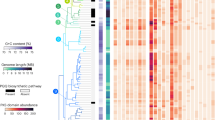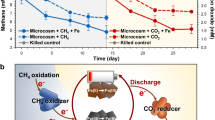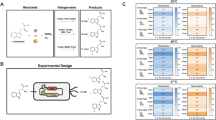Abstract
RECENT studies1 with a cellulose-producing culture of Acetobacter acetigenum NCIB 8132 revealed that this culture contained mutant organisms which were unable to produce extracellular cellulose (celluloseless mutants). Their presence in the wild-type culture was indicated by a mass-plating technique in which a large inoculum from a cellulose-producing culture was spread on the surface of glucose (3 per cent, w./v.), ‘Difco’ yeast-extract (0.5 per cent, w./v.) (GYE) medium (pH 7.0) containing agar (2 per cent, w./v.) ; mutant organisms showed a different colony type and a faster growth-rate than wild-type organisms. In GYE liquid medium parent organisms produced a cellulose pellicle, the medium under the pellicle remaining virtually clear. In contrast, mutant organisms grew diffusely in liquid medium and produced a moderate degree of turbidity. Despite the fact that mutant organisms could be detected in wild-type cultures by the mass-plating procedure, all our attempts to isolate mutants from cellulose-producing cultures by the indirect-select ion method of Lederberg and Lederberg2 have been unsuccessful. The present work was undertaken in an attempt to clarify this contradictory behaviour.
This is a preview of subscription content, access via your institution
Access options
Subscribe to this journal
Receive 51 print issues and online access
$199.00 per year
only $3.90 per issue
Buy this article
- Purchase on Springer Link
- Instant access to full article PDF
Prices may be subject to local taxes which are calculated during checkout
Similar content being viewed by others
References
Steel, R., and Walker, T. K., J. Gen. Microbiol. (in the press).
Lederberg, J., and Lederberg, E. M., J. Bact., 63, 399 (1952).
Author information
Authors and Affiliations
Rights and permissions
About this article
Cite this article
STEEL, R., WALKER, T. A Highly Specific Growth-inhibitory Factor produced by Certain Acetobacter Species. Nature 180, 811–812 (1957). https://doi.org/10.1038/180811a0
Issue Date:
DOI: https://doi.org/10.1038/180811a0
This article is cited by
-
Neues �ber den Stoffwechsel, die Systematik und Evolution der Essigs�ure-Bakterien
Archiv f�r Mikrobiologie (1962)
Comments
By submitting a comment you agree to abide by our Terms and Community Guidelines. If you find something abusive or that does not comply with our terms or guidelines please flag it as inappropriate.



